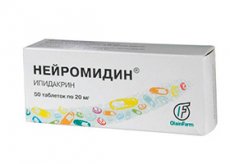Medical expert of the article
New publications
Preparations
Neuromidine
Last reviewed: 04.07.2025

All iLive content is medically reviewed or fact checked to ensure as much factual accuracy as possible.
We have strict sourcing guidelines and only link to reputable media sites, academic research institutions and, whenever possible, medically peer reviewed studies. Note that the numbers in parentheses ([1], [2], etc.) are clickable links to these studies.
If you feel that any of our content is inaccurate, out-of-date, or otherwise questionable, please select it and press Ctrl + Enter.

Indications Neuromidine
It is used in the following conditions:
- poly- and mononeuropathy of varying degrees of intensity;
- multiple sclerosis;
- paralysis or pathologies affecting the central nervous system;
- disorders of motor activity associated with organic lesions or injuries;
- Tablets can be prescribed for weak intestinal tone.
Release form
The component is released in tablets (10 pieces per pack) or in liquid form, inside 1 ml ampoules.
Pharmacodynamics
Neuromidin blocks the activity of Ca channels and reduces potassium levels, thereby increasing calcium levels inside nerve cells. At the same time, the drug prevents the effect of cholinesterase in the area of neuromuscular fibers. These processes allow increasing the number of conductors (adrenaline with serotonin, histamine and oxytocin) inside cells. At the same time, the activity of postsynaptic cells increases, and the conductors are able to penetrate the semi-impermeable cell wall. The drug stabilizes the transmission of neural impulses inside muscle tissue.
A patient who uses Neuromidin experiences increased smooth muscle tone, simplified memory processes, and restored synaptic connections within neural fibers.
Pharmacokinetics
The applied drug is synthesized with blood protein, passing into target organs at high speed. The drug undergoes intrahepatic exchange. Blood values of Cmax are noted after half an hour.
Excretion is carried out by the excretory system - with the participation of the gastrointestinal tract and kidneys (along with urine).
 [ 8 ]
[ 8 ]
Dosing and administration
The medication can be used in tablets or administered parenterally through injections (depending on the type of pathology and its intensity). No more than 200 mg of the substance can be used per day.
In case of mono- or polyneuropathy, the drug is administered intramuscularly or intravenously, in a dose of 30 mg (in 2 administrations), over a 10-15-day cycle. Then it is taken orally - 3 tablets per day (1 tablet 3 times) for a period of 1-2 months.
In case of movement disorders associated with various organic lesions or injuries, the substance is administered by intramuscular injection (15 ml), 2 times a day for a period of 15 days.
Combination therapy for multiple sclerosis involves taking 1 tablet of the substance 4 times a day for 2 months. This course must be repeated several times a year.
For intestinal atony, 20 mg of the drug is used 3 times a day over a 1-2 week cycle.
For various pathologies affecting the central nervous system, 5-15 mg of the medication is administered 2 times a day for a period of 10-15 days, or 1 tablet is taken 3 times a day for 3-6 months.
 [ 16 ]
[ 16 ]
Contraindications
The main contraindications for tablets:
- bradycardia or arrhythmia;
- epilepsy;
- stomach ulcers;
- asthma or allergy associated with individual components of the drug.
Overdose
Poisoning with the drug causes vomiting, bronchial spasms, nausea, decreased blood pressure, loss of appetite, a feeling of fear, impaired cardiac function (bradycardia or tachycardia), jaundice, convulsions and a feeling of general weakness.
Symptomatic measures are carried out, and cyclodol or atropine is administered.
Interactions with other drugs
Neuromidin potentiates the depressant effect on the central nervous system if it is administered together with sedative components.
The negative effects of the drug are potentiated when combined with other anticholinesterase drugs or ethyl alcohol.
The drug reduces the therapeutic activity of anesthetics.
The medicine can be combined with nootropic drugs.
 [ 17 ]
[ 17 ]
Storage conditions
Neuromidin should be stored in a dark place, out of reach of children. Temperature values are within the 25°C mark.
Shelf life
Neuromidin tablets can be used within 1.5 years from the date of production of the substance. The shelf life of the injection liquid is 1 year.
Application for children
The drug is prohibited for use in pediatrics (children under 14 years of age).
Analogues
The analogs of the drug are Amiridin 20 mg with Aksamon and Ipigrix, and in addition Proserin and Kalimin 60 N.
 [ 18 ]
[ 18 ]
Attention!
To simplify the perception of information, this instruction for use of the drug "Neuromidine" translated and presented in a special form on the basis of the official instructions for medical use of the drug. Before use read the annotation that came directly to medicines.
Description provided for informational purposes and is not a guide to self-healing. The need for this drug, the purpose of the treatment regimen, methods and dose of the drug is determined solely by the attending physician. Self-medication is dangerous for your health.

